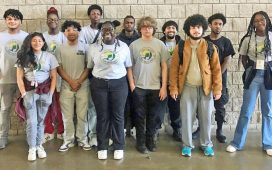Massachusetts State Police have quietly started using Boston Dynamics’ robot dog ‘Spot’ in a first for US law enforcement
- Boston Dynamics has leased its robotic dog Spot to state police
- This is the first known case of Spot being used by police anywhere
- The four-legged bot opens doors with its arm and can be controlled remotely
- Law enforcement say its used as a ‘remote observation device’
- Critics say they worry the robotic dog could be weaponized
Massachusetts police have begun rolling out Boston Dynamics’ futuristic breed of robotic dog in a first for law enforcement anywhere.
According to new documents obtained by the American Civil Liberties Union, the ‘dog,’ a four-legged robot named ‘Spot,’ has been involved in multiple police ‘incidents’ since being introduced in August, though the full details of those cases is not yet clear.
WBUR, who originally reported Spot’s introduction onto the force, said police used Spot as a ‘mobile remote observation device’ that was designed to investigate suspicious packages or sniff out where a suspect could be hiding.

A video from the Massachusetts State Police (pictured above) shows Spot using its robotic arm to open a door

State police in Massachusetts have deployed Spot on two known incidents, though it’s unclear exactly what those tag-alongs entailed
Spot, which comes equipped with a robotic arm for opening doors and a low-light camera can be operated autonomously or manually by remote.
The robot has turned heads often throughout its development for successfully carrying out feats like opening doors with its robotic arm using using a mixture of artificial intelligence and computer vision.
According to WBUR, provisions in Boston Dynamics’ contract with Massachusetts State Police stipulates that the department cannot be used to ‘physically harm or intimidate people’ which precludes the bot being equipped with a weapon.
Boston Dynamics says it sees Spot being implemented in a non-violent public safety capacity like rescue situations that are too risky for first-responders.
‘…the Mass State police is our only public safety-focused relationship to date. In the next 5-10 years, we see first responders utilizing Spot to get eyes on dangerous situations, inspect suspicious packages, as well as sense hazardous gases in emergency situations,’ Boston Dynamics told Gizmodo.
‘Sending a nimble robot like Spot into these situations can remove humans from potentially life-threatening environments and provide emergency responders with better situational awareness of a crisis.’
Despite Boston Dynamics’ reluctance to deploy its robots in a more offensive setting, civil rights groups like the ACLU have already voiced concern over where the technology might go from here.
‘We just really don’t know enough about how the state police are using this,’ Kade Crockford, director of the technology for liberty program at the ACLU of Massachusetts told WBUR.
‘And the technology that can be used in concert with a robotic system like this is almost limitless in terms of what kinds of surveillance and potentially even weaponization operations may be allowed.’
Boston Dynamics has just recently begun offering up its many robots to businesses, including a bipedal android named Atlas that is agile enough to execute back-flips and carry objects.









